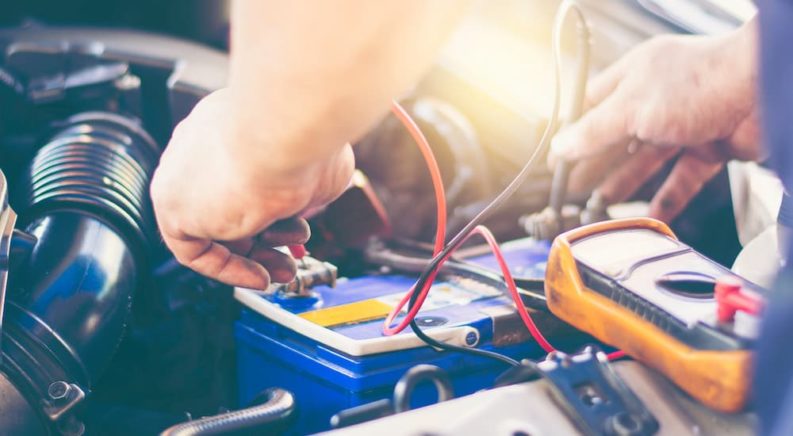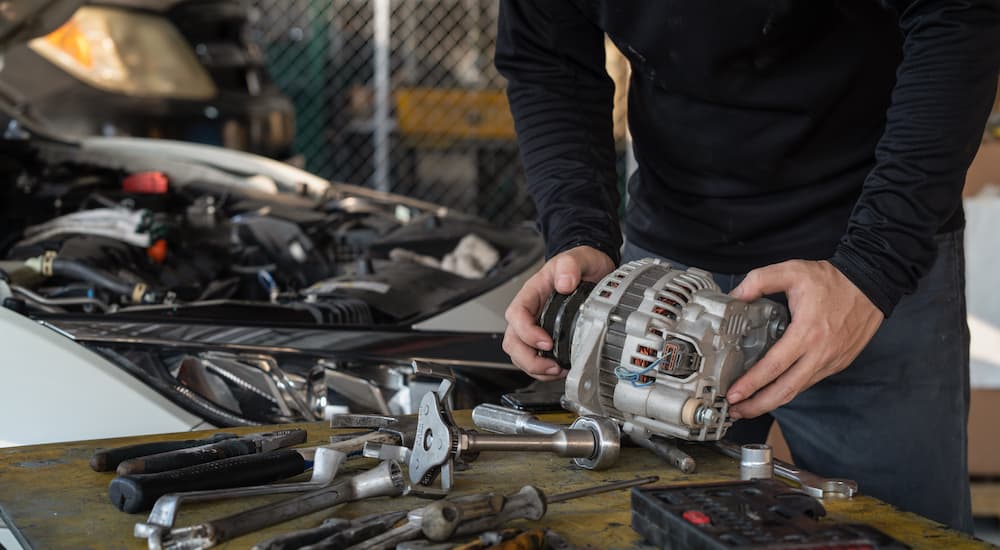The holidays have passed, and the weather outside is still very frightful. You’re (hopefully) nice and warm indoors, just thinking about how your car battery is holding up against the terrible conditions of a deep, bitter winter. I’ve got to say; it’s a suspiciously specific thought unless you recently experienced a dead battery or know someone who has – which is unfortunately common at this time of year! Maybe you’ve got a big off-road adventure and want to be prepared, eh? A bit of proactive research never hurt anybody, so I’m glad you’re here because skipping a Jeep winter battery service and winding up stuck in a Winter Nowhereland could suck all the “fa-la-la”s out of anything.
For vehicles with traditional ICE powertrains, a battery provides the spark of life. It’s a mighty duty for what seems on the outside like a simple plastic brick, and it isn’t a battery’s only role in a modern car either! Since you’re curious, let’s unravel a bit of the black box mystery of a lead-acid car battery. I’ll review what a battery does, discuss why winter is such a battery killer, and drop a couple of hot tips for keeping yourself powered up and ready to go all year-’round!
Why do Cars Need Batteries?
Batteries have been around for a while. The first true battery, a system that stores chemical energy that can be released as electrical energy, was created in 1800 by Alessandro Volta. On the inside, a battery is just a couple of metals, pastes, and chemicals that react with each other and release tons of electrons. When those electrons are given some place to go, electricity is produced.
Cars have also been around for a while, but it wasn’t clear from the first ride that the horseless carriage would need a source of electrical power as well as propulsion. As engineers overcame the most fundamental problems of the first automobiles, they quickly recognized the need for electricity for operator safety. Then, once a battery was regularly available, engineers found clever ways to manage and make use of it for more and more safety and comfort-oriented features – modern cars would be completely unrecognizable without batteries!
That’s because today’s car batteries serve three primary functions that are essential to the operation of a motor vehicle:
- Surge protection for the computers
- Power for electrical systems
- Starting the engine
Surge Protection
Power surges can frequently happen, even in your home. They are voltage spikes in excess of what your system is designed to handle. Sensitive devices in the path of a surge can be damaged by experiencing that much charge – like a fragile hose experiencing too much water pressure and weakening or bursting. In a car, these can happen all the time because of the highly variable output of the alternator (which is basically an electrical generator strapped onto the engine – it runs as fast as the engine does, changing its output constantly)!
That might not be a problem, except you might also have noticed that your car has tons of electronics vulnerable to surges. What if the lights on your dashboard blew out, or the infotainment shut down because you happened to run to the redline? How about electronic traction and stability control? What if everything went haywire because of damage to the central computer? Thankfully, the battery acts as a surge protector, dissipating excess voltage delivered by the alternator and preventing these spikes in power from getting to the essential and delicate electronics of the vehicle.
Power for Electronics
While the engine is running, the alternator creates a lot of electrical power – more than enough to run all your electronics in most cases. You experience the benefits of a battery any time you use the radio, power windows, or heated seats without starting the engine. It’s pretty straightforward – using electronics like the lights, radio, or power seat adjustments requires energy, and without the engine running, there’s only one way to get it.
Many of us have learned the hard way that this doesn’t work for too long. Leaving the electrical power on overnight is enough to drain the battery past the point of being able to start the car. It’s just not designed for that kind of use! Even if you avoid draining the battery completely, using it this way for extended periods results in permanent chemical damage that limits your battery’s capacity, so try not to make a habit of it, okay?
Starting the Engine
The battery’s oldest and most important function is to start the engine. Once ignition has been achieved and the engine is running, air and fuel are all it needs to keep going, but getting to that point from a standstill is a bit of a problem.
Worse than a bit, really. The original gas-powered automobile was started with a hand crank – you’d manually crank the engine through a few revs to give it momentum, activate the spark plugs, and (hopefully) achieve self-sustaining ignition. One of the major risks with this was that if the ignition timing wasn’t right, the engine could backfire – swinging the crank hard in the opposite direction!
The results would not be pretty. An unprepared motorist could easily break a wrist or an arm when this happened, or worse. In 1908, a Cadillac engineer named Byron Carter broke his jaw on a backfiring hand crank, leading to complications that ultimately took his life. This incident prompted Cadillac’s founder, Henry Leyland, to order the creation of a crank-free starting system – which Charles Kettering would deliver in three years with an onboard electric starter.
The mechanism hasn’t changed too much since then. Today’s vehicles are started with an ignition switch, closed by turning the key or pushing a button while the key fob is nearby. The switch activates the starter relay or solenoid, which closes an electrical circuit from the battery to the starter motor. The starter motor’s job is to turn a small gear that drives the crankshaft (and the attached flywheel) enough for ignition and sustained operation to begin, which takes a huge amount of power compared to a hand crank that could take advantage of leverage.
The battery can deliver hundreds of amps to make this happen – then, once ignition is achieved, the alternator takes over responsibility for supplying electricity to the systems and recharging the depleted battery.
Why Winter?
There are a few important factors that make winter dangerous for batteries. The most significant is how difficult it is to start an engine as temperatures plummet below freezing. Cold, thick oil makes it harder and harder to turn the crank, increasing the demand on the battery compared to summer start-ups. A battery that seems to be doing fine all summer could give up the ghost when it’s 10 below just because of the increased oil viscosity. This problem gets amplified for larger engines, which are inherently harder to start because of their size – there’s just that much more engine to move and oil to work through compared to a smaller block.
What this comes down to is the battery‘s capacity – does it hold enough energy to rapidly discharge and get that engine moving? The Cold Crank Amps (CCA) rating indicates whether it should – that’s a measure of how many amps it can sustain for 30 seconds when the temperature is 0 F, which is cold enough to slow the chemical reaction inside. It’s a standard method for communicating the maximum power a battery can deliver under adverse conditions. Your vehicle’s manual should include a recommendation for what rating you need, but when you shop around, you can always shoot for something with a greater capacity to compensate for a cold climate.
Whatever the rating, the battery’s actual capacity decreases with age and use, decreasing significantly if it suffers repeated “deep discharges” – that is, instances of prolonged use without the engine running. Batteries are prone to suffering deep discharges in the wintertime because more auxiliary systems are being used than usual. Defrosters and heated seats run the power demands up high, which means it takes longer for the alternator to recharge the battery after a cold start!
Suppose a battery can’t fully recharge during a short commute because of a challenging cold start and a heavily-taxed alternator. The effect is the same as leaving the lights on and walking away – a tiny bit of permanent damage is sustained, limiting the battery’s maximum charge and increasing the odds of a cold weather failure every time it happens. This adds up over weeks and months to shorten the life of the battery. Allowing the engine to run for at least 20 minutes after any cold start will reduce the risk of damage by this cause.

The Bottom Line
Ultimately, no matter how kindly you treat your battery, it will gradually lose capacity and become unreliable. Thousands of charge and discharge cycles take their toll; every time, some of the lead sulfate created during discharge won’t un-react to restore the original lead and sulfuric acid components. Gradually, less and less clean, exposed lead is available for discharging its electrons. In some cases, the acid electrolyte can even evaporate, reducing the full scale of the chemical reaction that can take place and thereby reducing the battery’s capacity.
Whatever the cause, the most likely time to discover a problem with your battery’s health is in the dead of winter, right when you need it the most. That’s why an annual diagnostic assessment is recommended for any motor vehicle, especially in the fall (before the going really gets tough). The impact of not doing so can range from inconvenience to utter catastrophe if you’re out in the wild and unprepared, so take measures to protect yourself and be safe out there! With a high CCA battery that you’ve taken good care of, you’ll be laughing all the way.


